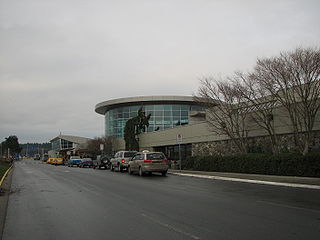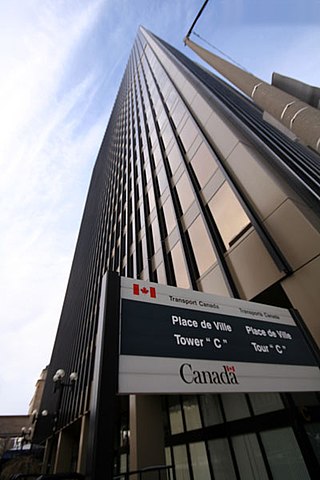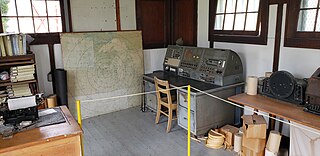Related Research Articles

Canada, the world's second-largest country in total area, is dedicated to having an efficient, high-capacity multimodal transportation spanning often vast distances between natural resource extraction sites, agricultural and urban areas. Canada's transportation system includes more than 1,400,000 kilometres (870,000 mi) of roads, 10 major international airports, 300 smaller airports, 72,093 km (44,797 mi) of functioning railway track, and more than 300 commercial ports and harbours that provide access to the Pacific, Atlantic and Arctic oceans as well as the Great Lakes and the St. Lawrence Seaway. In 2005, the transportation sector made up 4.2% of Canada's GDP, compared to 3.7% for Canada's mining and oil and gas extraction industries.
Air Canada is the flag carrier and the largest airline of Canada, by size and passengers carried. Air Canada is headquartered in the borough of Saint-Laurent, Montreal, Quebec. The airline, founded in 1937, provides scheduled and charter air transport for passengers and cargo to 222 destinations worldwide. It is a founding member of the Star Alliance. Air Canada's major hubs are at Toronto Pearson International Airport (YYZ), Montréal–Trudeau International Airport (YUL), and Vancouver International Airport (YVR).

Congestion pricing or congestion charges is a system of surcharging users of public goods that are subject to congestion through excess demand, such as through higher peak charges for use of bus services, electricity, metros, railways, telephones, and road pricing to reduce traffic congestion; airlines and shipping companies may be charged higher fees for slots at airports and through canals at busy times. Advocates claim this pricing strategy regulates demand, making it possible to manage congestion without increasing supply.

The London International Airport is an international airport located in London, Ontario, Canada. It is located 5 nautical miles northeast of the city of London, Ontario and is classified as an airport of entry by Nav Canada. In 2011, the airport was listed as the 20th busiest airport in Canada in terms of aircraft movements with 94,747 travels. The airport posted a record 683,000 travelers in 2019 and is forecasting 400,000 passengers in 2023. It provides services for cargo airlines and year-round flights with Air Canada Express and WestJet.

Billy Bishop Toronto City Airport is a regional airport located on the Toronto Islands in Toronto, Ontario, Canada. It is often referred to as Toronto Island Airport and was previously known as Port George VI Island Airport and Toronto City Centre Airport. The airport's name honours Billy Bishop, the Canadian World War I flying ace and World War II Air Marshal. It is used by civil aviation, air ambulances, and regional airlines using turboprop planes. In 2022, it was ranked Canada's ninth-busiest airport.

Jazz Aviation LP, commonly shortened to Jazz, is a Canadian regional airline based at Halifax Stanfield International Airport, in Enfield, Halifax, Nova Scotia, and is a wholly owned subsidiary of Chorus Aviation. Jazz Aviation provides regional and charter airline services in Canada and the United States, primarily under contract to Air Canada using the brand name Air Canada Express, and also as Jazz Charters.

Montréal–Mirabel International Airport, originally called Montréal International Airport, widely known as Mirabel and branded as YMX International Aerocity of Mirabel, is a cargo and former international passenger airport in Mirabel, Quebec, Canada, 21 nautical miles northwest of Montreal. It opened on October 4, 1975, and the last commercial passenger flight took off on October 31, 2004.

Victoria International Airport serves Victoria, British Columbia, Canada. It is 12 nautical miles north northwest of Victoria on the Saanich Peninsula, with the bulk of the airport in North Saanich, and a small portion of the airfield extending into Sidney. The airport is run by the Victoria Airport Authority. YYJ has many nonstop daily flights to Vancouver International Airport, which is a major airport serving many global routes. Additionally, Victoria International has nonstop service to Seattle (SEA), Toronto (YYZ), Montreal, Calgary (YYC), Edmonton (YEG), and several smaller cities in British Columbia and Yukon. The airport also has seasonal nonstop service to several Mexican resort destinations. Non-stop service between Victoria and the United States decreased by 50% at the beginning of September 2019 when Delta Airlines permanently ended its three daily flights to Seattle, after which only Alaska Airlines continued to fly the route.

Fredericton International Airport is an airport in Lincoln, New Brunswick, Canada, 7 nautical miles southeast of Fredericton.

Transport Canada is the department within the Government of Canada responsible for developing regulations, policies and services of road, rail, marine and air transportation in Canada. It is part of the Transportation, Infrastructure and Communities (TIC) portfolio. The current Minister of Transport is Pablo Rodriguez. Transport Canada is headquartered in Ottawa, Ontario.

Nav Canada is a privately run, non-profit corporation that owns and operates Canada's civil air navigation system (ANS). It was established by statute in accordance with the Civil Air Navigation Services Commercialization Act.

Ottawa/Macdonald–Cartier International Airport is the main international airport serving Ottawa, Ontario, Canada, and its metropolitan area as well as Gatineau, Quebec known as the National Capital Region. It is named after the Canadian statesmen and two of the "founding fathers of Canada", Sir John A. Macdonald and Sir George-Étienne Cartier. Located 5.5 nautical miles south of downtown Ottawa in the south end of the city, it is Canada's eighth-busiest airport, Ontario's second-busiest airport by airline passenger traffic, with 2,992,334 passengers in 2022. The airport is a home base for Canadian North.

The Toronto Port Authority (TPA), doing business as PortsToronto (PT), is a port authority that is responsible for the management of the Port of Toronto, including the International Marine Passenger Terminal, and Billy Bishop Toronto City Airport. It was established under the Canada Marine Act as a government business enterprise that is self-funded, with directors appointed by three levels of government – the Government of Canada, the Government of Ontario and the City of Toronto. The TPA rebranded itself as PortsToronto in 2015.

A flight service station (FSS) is an air traffic facility that provides information and services to aircraft pilots before, during, and after flights, but unlike air traffic control (ATC), is not responsible for giving instructions or clearances or providing separation. They do, however, relay clearances from ATC for departure or approaches. The people who communicate with pilots from an FSS are referred to as flight service specialists.

Windsor International Airport is located in the southeast portion of the city of Windsor, Ontario, Canada. The airport serves a mixture of scheduled airline flights and general aviation, and is a popular point of entry into Canada for private and business aircraft. The airspace above the airport is exceptionally busy because of the proximity to Detroit Metropolitan Airport, and Instrument Flight Rules (IFR) arrivals and departures are handled by Detroit approach control.

Toronto Pearson International Airport is an international airport located in Mississauga, Ontario, Canada. It is the main airport serving Toronto, its metropolitan area, and the surrounding region known as the Golden Horseshoe. The airport is named in honour of Lester B. Pearson, who served as the 14th Prime minister of Canada (1963–1968) and received the Nobel Peace Prize in 1957 for his humanitarian work in peacekeeping.
The Halifax International Airport Authority (HIAA) is a Canadian airport authority charged with operating Halifax Stanfield International Airport on behalf of Transport Canada.

Canadian Forces Base Trenton, formerly RCAF Station Trenton, is a Canadian Forces base located within the city of Quinte West, Ontario. It is operated as an air force base by the Royal Canadian Air Force (RCAF) and is the hub for air transport operations in Canada and abroad. Its primary RCAF lodger unit is 8 Wing, commonly referred to as 8 Wing Trenton. CFB Trenton is Canada's largest Air Force base and most southerly air base.
Transport or transportation is the intentional movement of humans, animals, and goods from one location to another. Modes of transport include air, land, water, cable, pipelines, and space. The field can be divided into infrastructure, vehicles, and operations. Transport enables human trade, which is essential for the development of civilizations.
The Cameroon Civil Aviation Authority is a public administrative establishment of a technical nature that ensures the implementation of civil aviation regulation policy, the monitoring of air transport and airport development, as well as the control and regulation of civil aviation safety andsecurity.
References
- ↑ Transport Canada (August 2006). "National Airports Policy" . Retrieved 2008-05-03.
- 1 2 Canadian Owners and Pilots Association (January 2008). "The COPA Guide to Public Airports" (PDF). Retrieved 2008-05-03.